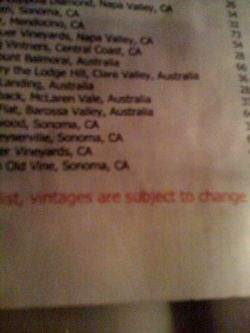By Evan Dawson, Finger Lakes Editor
Editor's Note: The photograph, taken in the low restaurant lighting, shows the offending disclaimer mentioned in the text below.
I had a horrible wine experience at a popular restaurant this week, and yet I don't want to unfairly malign the restaurant involved. My friends know that I'm constantly talking about service in all industries — in a competitive and hurting economy I find the easiest way to differentiate yourself is through stellar service — and yet I don't want to be unfair. This was one server on one night, hardly a large enough sample size to declare a service black hole.
But in this case, the restaurant is at fault as well. More on that to come.
My wife and I joined two friends for dinner at Jojo in Pittsford outside Rochester. It's an extremely popular and trendy restaurant offering high-end entrees as well as delicious $11 burgers. The wine list is long but mediocre, and that's where we ran into trouble.
Looking for a red wine, I waded through the usual suspects (Charles Krug, Robert Mondavi, Chateau St. Jean, etc) and discovered a gem: a 2001 Col D'Orcia Brunello di Montalcino. I was excited because 2001 was considered a wonderful vintage in Tuscany and Col D'Orcia makes more old-school, rustic Brunellos. We happily ordered a bottle.
The waitress eventually emerged with the bottle and presented it to the table while getting ready to insert the corkscrew. Thankfully I noticed that she had brought a bottle of the 2002 Col D'Orcia. Being the Brunello lover that I am, I knew that there was an enormous difference between 2001 and 2002. While 2001 was a dream, 2002 was a nightmare, with disastrous weather ruining harvest. Most producers didn't even bottle their Brunello in 2002. (Wine Spectator, for example, scored the 2001 Tuscan vintage 98 points, while 2002 earned 78 points).
I didn't want to be difficult and, knowing that many servers don't have a deep reservoir of wine knowledge, I didn't want to embarrass the waitress. I simply said, politely, "I'm sorry, we had ordered the 2001." She stared blankly at me. I continued, "It's no problem, but please don't open that bottle. I'm sure we can find something else if the 2001 is not available."
At this point I guess I expected the waitress to offer a half-apology or some assistance in finding an alternate wine. Nope. She went from agape to seemingly furious, glaring at me without speaking. I felt awkward. She clearly had no clue why this wine snob would raise a fuss over a bottle. I could practically hear her shouting, "It's the same wine, idiot!" Of course, it's not the same wine, and I'm surprised to see that Spectator notes about the 2002 Col D'Orcia (after scoring it 77 points), "Not imported into the U.S." This was not like comparing apples to apples. It was like comparing apples to garden rakes.
My wife and friends were just as startled by the waitress' reaction as I was. For the remainder of the meal she continued to be terse and awkward, and it made the evening rather uncomfortable. We noticed on the wine list a disclaimer that seemed designed to get them off the hook in times like these: "Due to our extensive wine list, vintages are subject to change." Again, I don't mean to be rude, but let me go ahead and translate that: "Our wine list is long enough that we feel it's an excuse to be lazy and not update the vintages when they change. So don't blame us."
The disclaimer should have been a warning that this restaurant is not serious about wine. Then we noticed that NONE of the white wines by the bottle were listed with vintage. We took this as a statement by the restaurant that white wines are some kind of inferior species — which they are very obviously not. An excellent new restaurant in Geneva, New York called Halsey's boasts a diverse and interesting wine list that is marred by the fact that their Finger Lakes bottle list does not display vintages. What does that tell the customer about their opinion of local wine?
The bottom line is this: Service matters, and so does vintage. Yes, there are sterilized, mass-produced wines that taste roughly the same every year. But most wines will show at least some, and often significant, variation. Weather is the obvious factor, but there's cropping, winemaking techniques, grape sourcing… the list is long. Restaurants that don't find vintages to be important are telling their customers that they don't understand or care about wine. Poorly trained service staff only cement that point. And while I'm a self-acknowledged wine geek, I should not be made to feel like the jerk in the room when I have to point this out.
I'll return to Jojo; I enjoy the food and atmosphere. But next time I'll bring my own bottle and pay the corkage fee.

